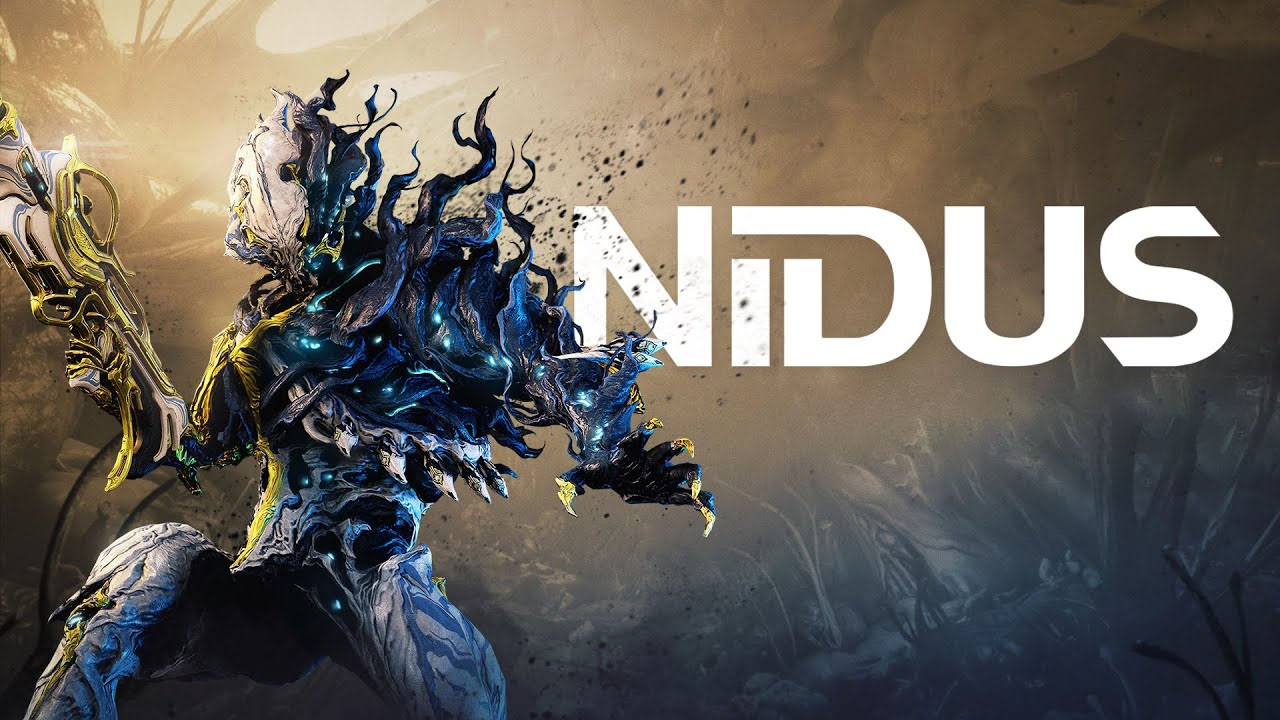This is a beginner’s guide to the mechanics and gameplay-loop of NIDUS.
It includes the basic controls, various obvious and not-so-obvious mechanics and features which are essential to progress efficiently, and basic ways to deal with certain enemies and bosses alongside explaining simple combos and opportunities to take.
Player Controls
Core mechanic
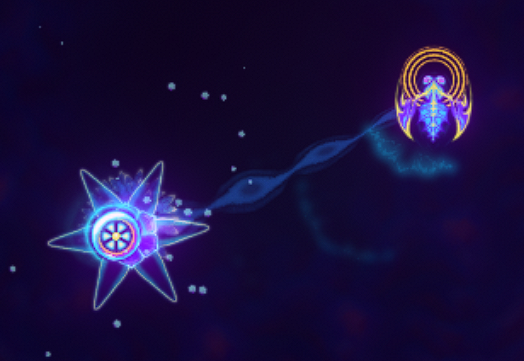
You control both a Flower and a Wasp using either both joysticks on a controller or WASD and the mouse otherwise. You can configure which side controls who in the settings.
The wasp is quick and agile and is immune to all damage with a couple exceptions, (More on those later). It moves independently but is constrained by the maximum distance it can travel away from the flower.
The flower is on the other hand is quite slow and heavy and will take damage from any enemy and or attack. Unlike the wasp it is only constrained by the bounds of the arena itself.
To master the vast mechanics this game offers you must first get used to this decoupled way of playing, being able to control both characters independently from each other. Though that is maybe the simplest feature to lock in.
Actions
Both characters come with their own Action button being either bumpers / triggers on a controller or shift and mouse click otherwise. You can configure the action button for the whatever character WASD controls in the settings.
Both characters have 2 distinct actions which are categorized by holding down the action button or letting it go paired with any directions that are being held.
When the action button is held for the wasp it spins into a big continuous blade which damages enemies and converts ichor (Red hurting projectiles) into essence.
Spinning will also gradually drain the wasps energy, indicated by the yellow radial progress bar in its center. Once the wasp runs out of energy it can not perform any actions and must recharge by touching the flower.
When the action button is released for the wasp it will stop spinning, but if a direction is being held it will perform a dash which damages enemies hit by it.
When the action button is held for the flower it will stop moving and begin to bloom with a radius around it which will mark any weak points of any enemy inside it.
While its blooming the wasps speed will increase both when flying and when spinning.
When the action button is released for the flower it will stop blooming, but if a direction is being held it will also perform a dash which grants a small time period of invincibility. Note that this action will hurt the flower!
Need to know
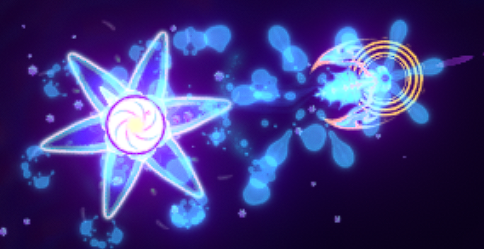
When the wasp recharges by touching the flower the flower gets a small speed boost alongside healing faster. Use it wisely to stay away from danger.
Basics of combat
The basic premise is that the wasp is the main source of damage and the flower acts as a health tank, but that does NOT mean the flower is unable to defend itself. It is actually quite the opposite! With the wasps help the flower can output more damage overall which is the recommended strategy to deal with hoards of enemies or bosses.
Wasp basics
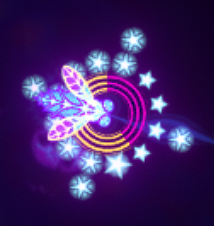
When the wasp kills an enemy or converts ichor it gathers essence around itself, visible by stars circling it. Essence can also sit somewhere in the arena which can be picked up by either character manually.
If the wasp recharges all the gathered essence gets deposited, not only healing the flower but also making it spew out blades that damage enemies. The longer the attack gets carried out for the stronger the blades will become, so depositing more as the attack is still going increases its duration and therefore damage output!
Flower basics
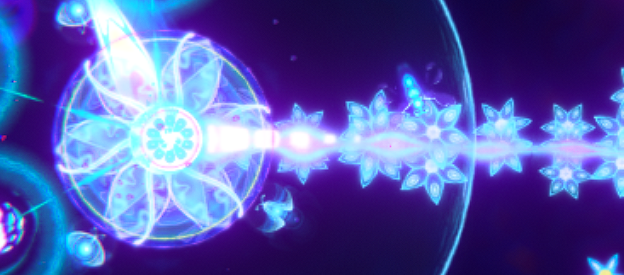
During the flowers attack the blades will spew out from its center, spiraling outwards towards a maximum radius. However if the flower is blooming and holding a direction it will focus all the blades to fire towards that direction with a small degree of spread. This is the only attack that can shred bosses in seconds!
Enemy basics
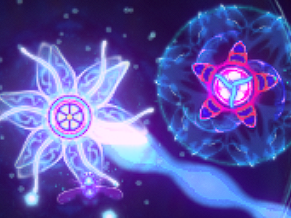
Most enemies come with a shielded weak point which needs to get marked by the flower to become permanently exposed for the wasp to take care of. Else nothing is going to be able to damage them. Note that the flowers bloom can also damage certain bugs, although the damage output is miniscule.
That is about the basis of the combat loop.
- Keep flower away from foes, or close if you need to mark them.
- Attack enemies with the wasp to gain essence.
- Deposit essence to make the flower attack and heal.
- Repeat.
Advanced combat mechanics
Opportunities
While both characters have their own unique mechanics to progress through the game. They can also interact with each other for even more mechanics that all serve a purpose. Note: Most of these are already listed in the Tips panel in the game.
Bounces
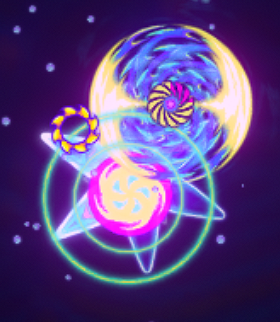
When the wasp touches the flower whilst spinning it will bounce off the flower. When enemies are near the wasp automatically bounces towards the closest target. Note that the wasp moves faster when the flower is blooming which makes this a great mechanic to use to take care of a hoard of shielded enemies. Any essence the wasp may be holding will also not be deposited.
Echo blades
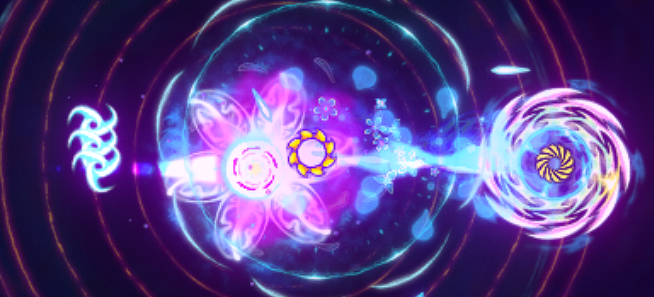
When the bounce is performed but while the flower is holding a direction and blooming it will spew out a trio of blades in the desired direction that travel quite a distance. I advise using it to hit critters far away from the flower or bosses where the weak point is hard to get to. Performing this action will damage the flower so use it cautiously.
Blink dash
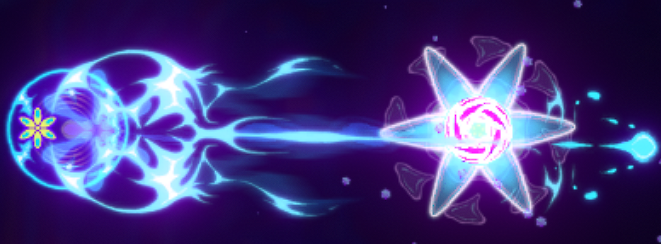
When the wasp dashes through the flower it sends the wasp flying further and creates a rather big area of effect that damages enemies.
Bloom dash
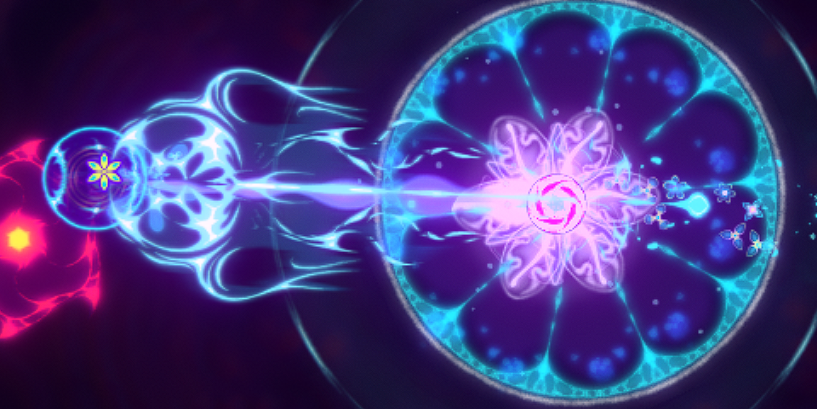
The same as a Blink dash but while the flower is blooming. Has an increased area of effect and deals more damage. Performing this action will damage the flower so use it cautiously unless you have essence which cancels out the damage.
Mastering these mechanics and performing them strategically will open up the high score opportunities!
Enemies
NIDUS offers a great range of enemies each wit their own unique quirks and behavior. However some share certain quirks which is why I’m going to categorize them under the most common ones.
Small bugs
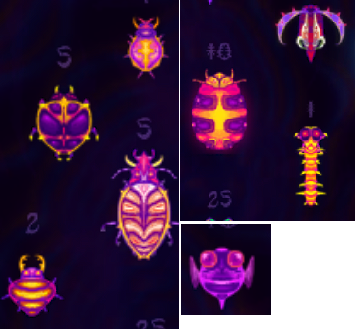
These are bugs that can be killed easily without needing to mark them. I recommend maneuvering around them to gather them tightly then let the wasp take them out. Or letting the flowers blades kill them if you have essence.
Exception being the flower-relative bugs that do not adhere to the flowers movement and must be dealt with quickly before they reach the flower.
Regular bugs
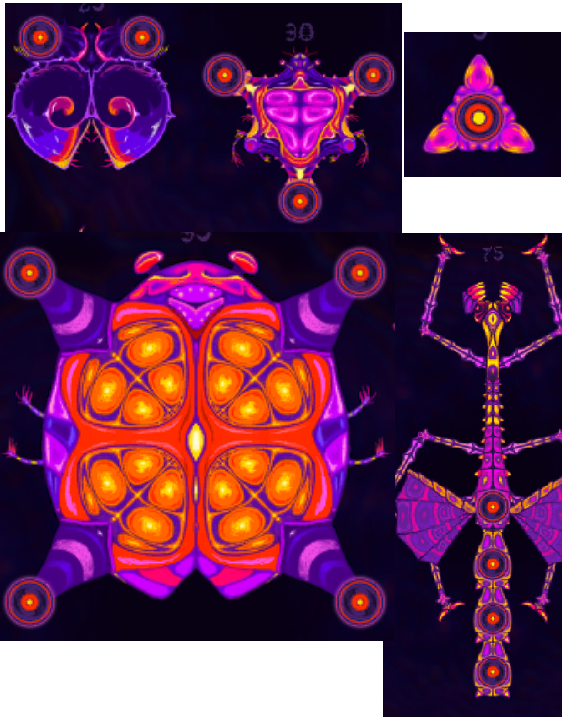
These are bugs that can be killed easily without needing to mark them as well. However their greater sizes and unique mechanics such as spawning small bugs or creating explosions makes for enemies to look out for and consider in your strategy. Best course of action is to dodge their attacks and kill them whenever you have the opportunity to.
Shielded bugs
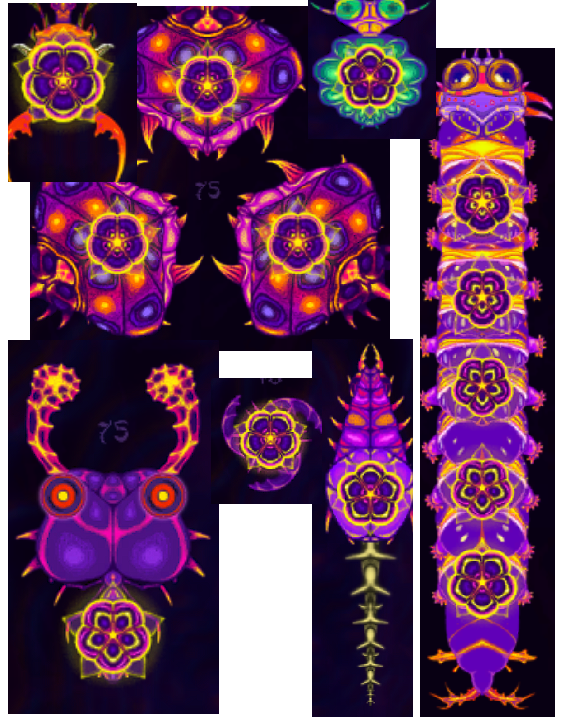
These are bugs that can not be killed unless they have been marked by the flower. Some also require certain strategies to kill efficiently.
- Caterpillar: Force it around the flower, bloom and dash away finishing it off with the wasp. Keep in mind it speeds up the less weak points it has!
- Ant: Approach it from the sides or from behind as its turning radius is quite high.
- Piercer: Approach it from the side and immediately create distance, it acts like a double edged sword once its tongue is out.
- Triplet: Get within its triangle, bloom and dash away to mark all segments, finish off with wasp.
Wasp killers
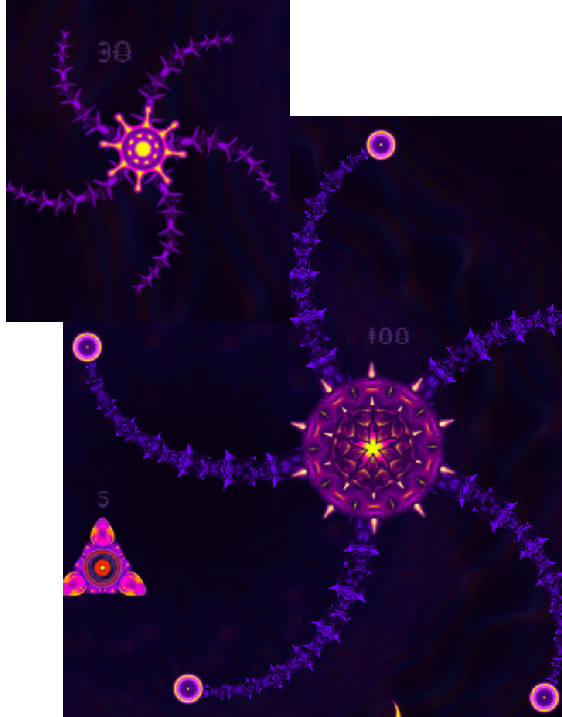
These are the types of enemies that have the ability to kill the wasp, aka drain its energy with yellow flashing tendrils, Forcing it to retreat back to the flower to recharge. These are very dangerous enemies that need to be dealt with carefully.
- Starfish: are generally harmless because it can be killed by the flower alone. Once marked will form into a harmless sphere.
- Great Starfish: Possibly the most annoying enemy with its sheer size and moving tendrils. You can either strategically slice the weak points with the wasp or bloom them with the flower to destroy them. Once all segments are destroyed it will become a harmless flower.
- Piercer: Do I need to say anything?
Important notes

Killing any enemy will spawn a Nymph which when bloomed, will assist the wasp in dealing damage. If its left untouched for too long it will despawn!
Killing a spawner bug before its first spawn will spawn scarab bugs. They also have a scarab design on them before it’s too late.
Bosses
NIDUS’ progression runs on a set of “worlds” you can choose to traverse and defeat the respective boss at the end. The first being always the tutorial world.
Once a boss is defeated you will be able to upgrade the flower or the wasp with incrementing levels. Upgrading the flower adds additional flower shields circling it and upgrading the wasp increases its damage output. After the upgrade has been taken you will be able to choose between 5 realms to conquer each with their boss visible when going near the weak point.
Note that once a boss is killed you will no longer be able to fight it again and every boss will become slightly more difficult. The last boss you fight will be Exalted!
Calyx
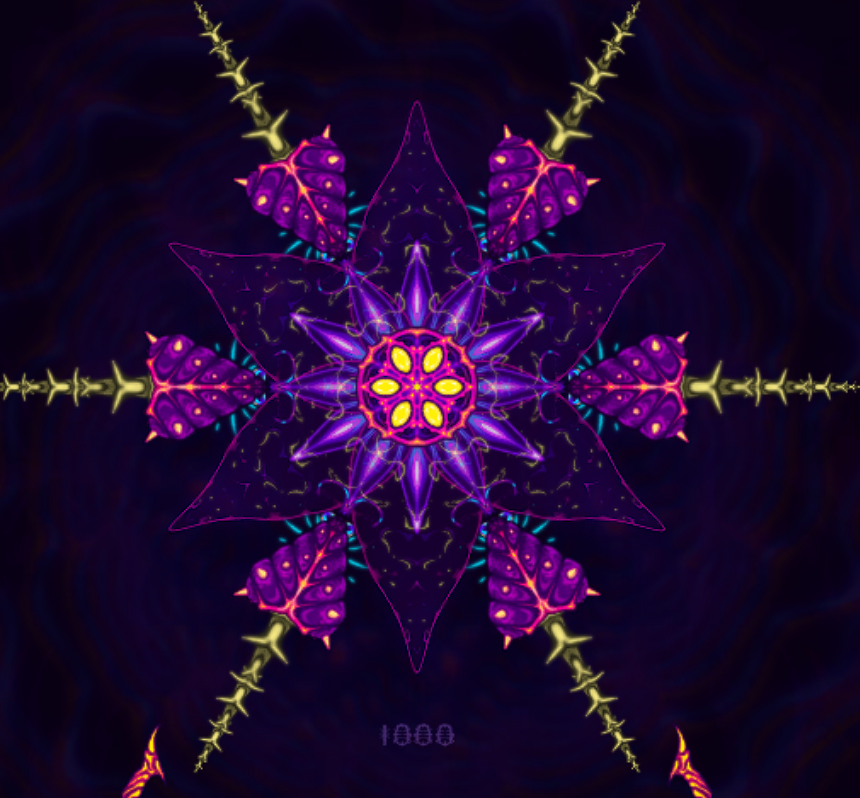
A great introduction to the basis of the bosses, with an initial egg you have to break open before fighting the actual boss which will have one or more weak points.
Generally not a threat however its leaf spiral will speed up the less health it has so make sure to kill it quickly.
Hoplite
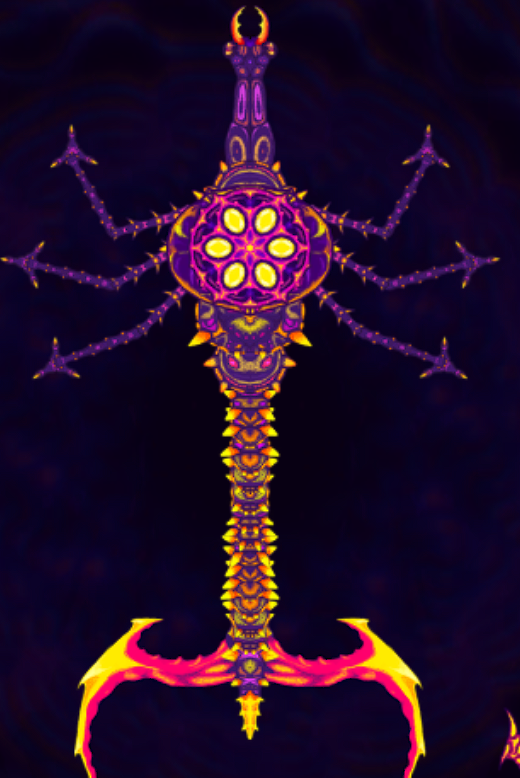
Located at the top of the realm list this is the first serious boss that most players will choose. Its basic attacks include spewing out projectiles and trying to attack the flower with its tail whilst having a constantly exposed weak point. This boss mostly tests your ability to dodge and learn common patterns.
Gigant
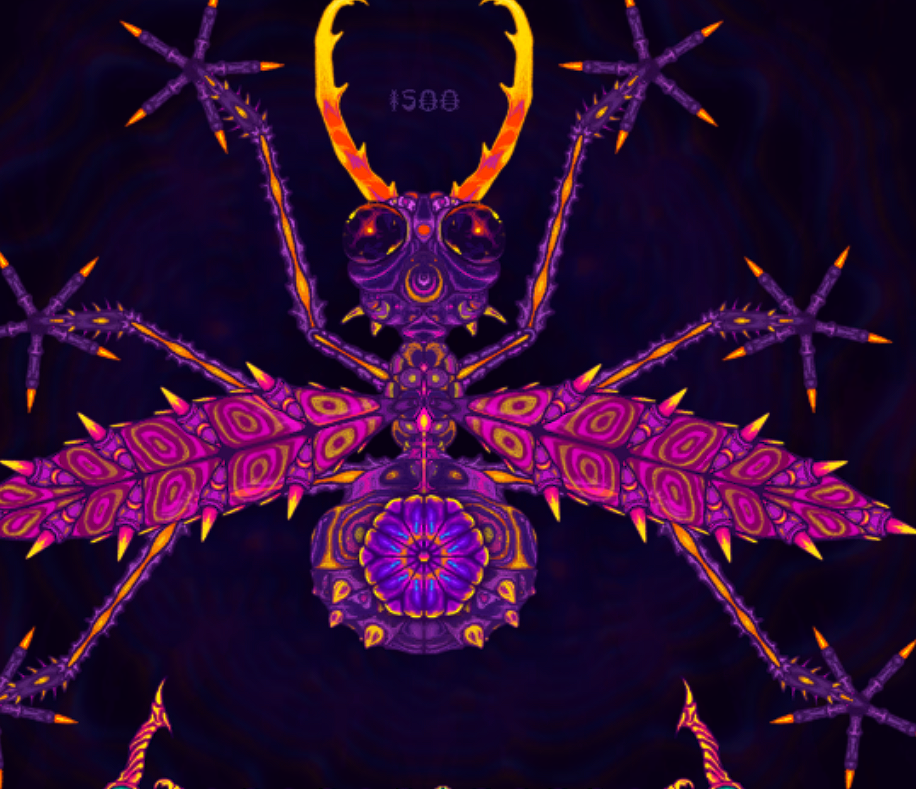
Located at the top right of the realm list this boss can intimidate someone quite easily due to its sheer size and sharp extended legs which also deal damage. The surprise lies within its second phase where wasp-killing tendrils will extend from its eye sockets as its weak point on the abdomen gets exposed. This boss tests your ability to maneuver the wasp and get a sense of quick decision making since it has a couple attacks that may or may not come unexpectedly.
Tetrad

Located at the bottom right of the realm list this boss is basically a glorified extension of the Triplet enemy where instead of 3 segments there are 4. Alongside that gimmick it also has each segment rotating and spewing out projectiles both outwards and inwards. This boss tests your ability to protect the flower and take opportunities.
Harbinger
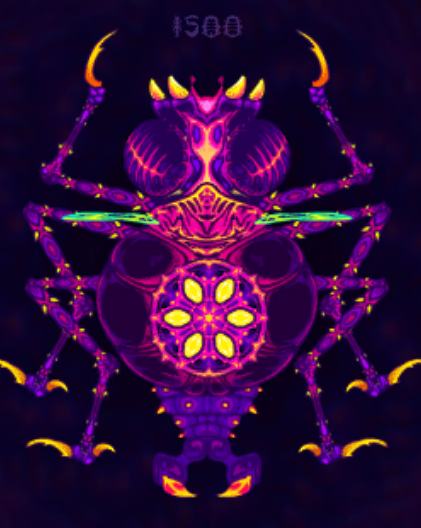
Located at the bottom left of the realm list this boss is a chaotic mess with multiple attacks ranging from mass projectile spawning to flower chasing. It poses a great opportunity to test your mechanics with the flower as there is quite some essence to collect as it zooms around the arena. This boss tests your ability to make micro decisions and perform set ups for big attacks.
Banshee
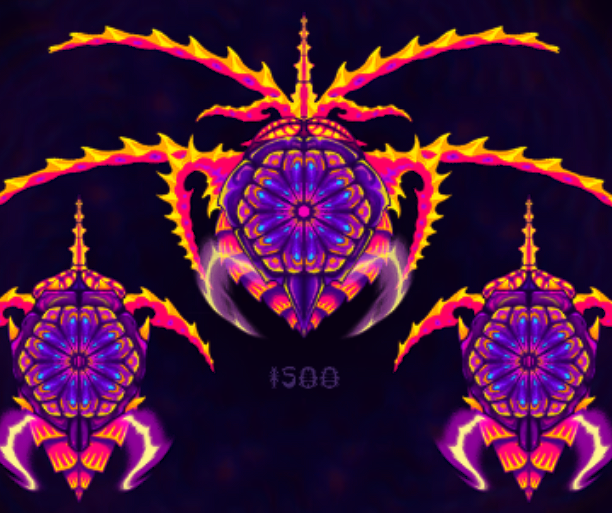
Located at the top left of the realm list this boss is a nightmare to fight for newer players. Its main gimmick being consisting of multiple segments each with their own weak point. Once a weak point has been destroyed the respective segment will split off the main body and will periodically dash towards the flower or spew out projectiles which can get overwhelming at later stages. This boss tests your ability to deal damage quickly and efficiently.
Zenith
To be updated.
Exalted bosses
Exalted bosses are the strongest form of them with the unique quirk of having the weak points surrounded by wasp killer tendrils, forcing you to bloom it before attacking. This creates an interesting twist which forces you to take more risks and get up close and personal.
Note: If you take too long to kill a boss invincible mosquitos will spawn and attack the flower!
Scoring
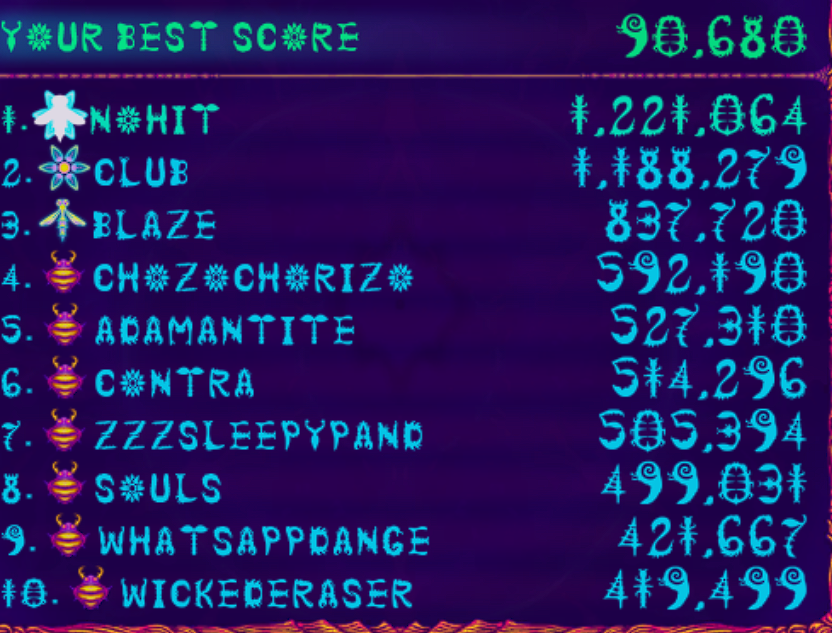
NIDUS has a rather simple scoring system with a few exceptions.
- Killing enemies or bosses rewards the points listed in the gallery.
- Depositing essence also rewards points based on fire-duration.
Yes. There is a combo system.

When essence gets deposited the combo meter fills up, and once full will raise the flower combo by some amount (Also visible on the flower itself). While the combo is active any points earned will be multiplied by the respective amount.
Once combo level 6 has been reached the flower will shine and the combo will be maxed out at 21. However you can still fill the combo meter and once full will spawn a butterfly to collect which grants essence and extra points.
When the flower takes damage the combo resets. Note that that only goes for damage inflicted by enemies, any action by the wasp or the flower that decrease its health do not reset the combo!
Timing
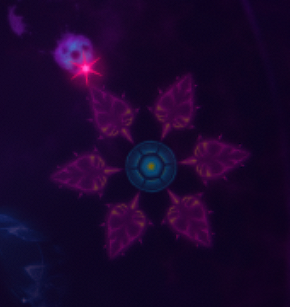
Every wave has a set amount of idle time that slowly counts down, shown as a red spark progressing through 6 transparent flowers outside the boundary of the arena. Every flower it has passed gets marked as disabled. If all the flowers get disabled the next wave begins on its own. However if you kill all enemies in the wave you will progress to the next wave, and every active time flower will spawn a small Fairyfly which when collected, gives essence and some points. So make sure to be quick as the leader-boards also have a speed run category!
Difficulties

For accessibility reasons NIDUS also offers 4 entire difficulty options:
- Resilient
- Delicate
- Fragile (Unlocked after completing Delicate)
- Brittle (Unlocked after completing Fragile)
All they do is change how much health the flower has and the score multiplier, making low difficulty runs both easier and less rewarding. Note that Brittle is the permadeath mode where you can’t get hit once!
Routing
Thanks to the vast mechanics and dynamic opportunities NIDUS offers, routing is a valid option to grind for the highest of scores because the waves do not change.
The easiest way to find your preferred routes is to have priorities and execute them in sequence, like for example:
- Small bugs first
- Wasp killers next
- shielded bugs come after unless they are close etc etc.
It is all just a weaved sequence of choosing what to do, when to do it and how to do it with a little bit of wiggle room to allow for rng to change things up a bit.
